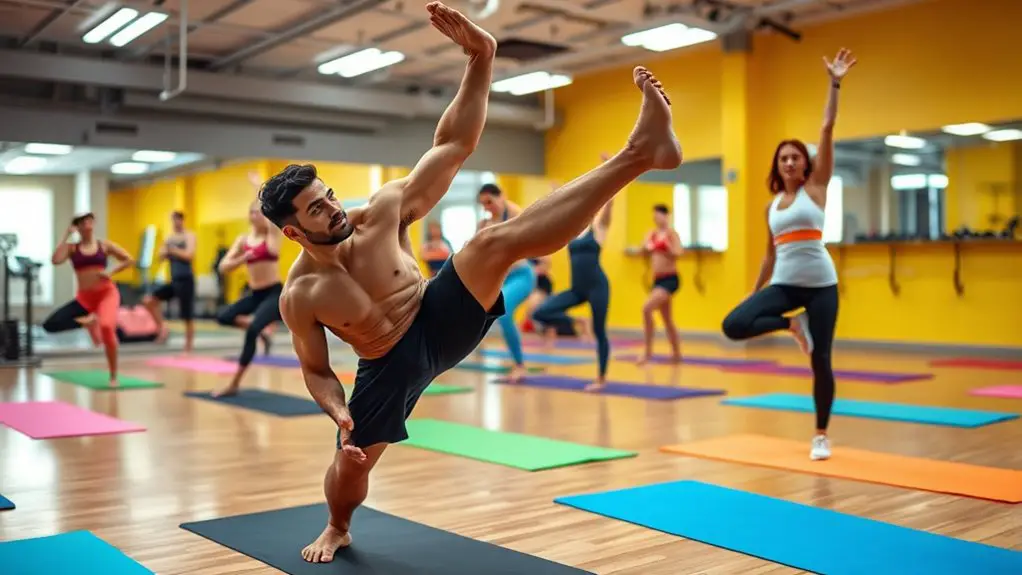After a workout, it's important to stretch to aid recovery and enhance performance. Focus on key stretches like hamstrings, quadriceps, hip flexors, shoulders, and chest to improve flexibility and reduce soreness. Don't forget about calf and spinal twist stretches, too! Incorporating a full-body stretch routine will help you relax and prevent stiffness. For tips on specific techniques and additional stretches, you'll find plenty of helpful information to boost your post-workout routine.
The Importance of Stretching After Workouts
While you might feel tempted to skip stretching after a workout, it's essential for your recovery and overall performance. Stretching helps to relax your muscles, reduce soreness, and improve flexibility, which can enhance your freedom of movement during your next workout. When you take the time to stretch, you're allowing your body to return to its natural state, preventing stiffness and promoting better circulation. This simple practice can also help you maintain balance, reducing the risk of injuries that might hold you back from pursuing your athletic goals. So, instead of rushing off to your next adventure, embrace the moment and prioritize stretching—your body will thank you, and you'll be ready to release your full potential next time you hit the field or gym.
Hamstring Stretch
If you want to enhance your flexibility and prevent tightness, incorporating a hamstring stretch into your post-workout routine is essential. This stretch not only helps you recover but also keeps you moving freely. Here's how to do it:
- Sit on the ground with one leg extended and the other bent, foot against the inner thigh of the straight leg.
- Reach for your toes on the extended leg, keeping your back straight, and feel the stretch in your hamstring.
- Hold the position for 15-30 seconds, breathing deeply to relax into the stretch.
- Switch legs and repeat, ensuring both sides get equal attention.
Quadriceps Stretch
A well-rounded post-workout routine wouldn't be complete without a quadriceps stretch. This stretch helps alleviate tightness in your quads, promoting flexibility and recovery. To perform it, stand tall and grab your right ankle with your right hand, pulling it toward your glutes. Keep your knees together and push your hips slightly forward. You'll feel a gentle stretch along the front of your thigh. Hold for about 15-30 seconds, then switch sides. If balance is an issue, grab onto a wall or a sturdy surface. This simple move not only enhances your range of motion but also helps prevent injuries, allowing you to enjoy your athletic pursuits with freedom and ease. Embrace the stretch and feel the difference!
Hip Flexor Stretch
One key stretch that should be part of your post-workout routine is the hip flexor stretch. It's essential for keeping your hips flexible and your body free. Here's how to do it:
- Start in a lunge position: One knee on the ground, the other foot in front, forming a 90-degree angle.
- Engage your core: Keep your back straight and your hips tucked.
- Shift your weight forward: Feel the stretch in the hip of the knee on the ground.
- Hold for 20-30 seconds: Breathe deeply and relax into the stretch.
Incorporating this stretch will enhance your freedom of movement, ensuring you're ready for whatever comes next in your athletic journey.
Shoulder Stretch
Shoulders play an essential role in almost every athletic activity, making a proper shoulder stretch important for recovery. After a workout, you need to release any tightness and promote mobility in this significant area. One effective stretch involves extending one arm across your body and gently pulling it closer with your opposite hand. Hold for about 15-30 seconds, feeling the stretch along your shoulder and upper back. Switch sides and repeat. Another great option is the doorway stretch; simply place your hands on either side of a doorframe, lean forward slightly, and feel that delicious opening in your shoulders. Incorporate these stretches into your routine, and you'll enjoy greater freedom of movement and reduced risk of injury. Your shoulders will thank you!
Chest Stretch
Stretching your chest after a workout is essential for maintaining flexibility and preventing tightness. It helps open up your shoulders and promotes better posture, giving you that freedom of movement you crave. Here's how to do a simple chest stretch:
Stretching your chest post-workout enhances flexibility, improves posture, and allows for greater freedom of movement.
- Wall Stretch: Stand next to a wall, place your hand on it, and gently turn away until you feel a stretch in your chest.
- Doorway Stretch: Stand in a doorway, place your arms at 90 degrees, and lean forward to deepen the stretch.
- Cobra Pose: Lie face down, push up with your hands, and lift your chest while keeping your hips on the ground.
- Seated Stretch: Sit cross-legged, interlock your fingers behind your back, and gently lift your arms to feel the stretch.
Enjoy the freedom of movement!
Calf Stretch
After addressing your chest, it's time to focus on your calves, which play an essential role in lower body movement and stability. A good calf stretch can enhance flexibility, improve performance, and reduce the risk of injury. Here's how to do it:
- Stand facing a wall, place your hands on it.
- Step one foot back, keeping it straight.
- Bend your front knee, feeling the stretch in the back calf.
- Hold for 15-30 seconds, then switch legs.
| Muscle Group | Stretch Type | Benefits |
|---|---|---|
| Gastrocnemius | Standing Calf | Increases flexibility |
| Soleus | Seated Calf | Reduces tightness |
| Achilles | Wall Stretch | Enhances mobility |
| Overall | Dynamic Stretch | Improves performance |
Embrace this freedom in movement!
Spinal Twist Stretch
While you're working on your flexibility, the spinal twist stretch is an excellent way to release tension in your back and improve spinal mobility. This stretch not only feels great but also enhances your overall freedom of movement. Here's how to do it:
- Sit on the floor with your legs extended in front of you.
- Bend your right knee and place your foot on the outside of your left thigh.
- Twist your torso to the right, using your left elbow to gently press against your right knee.
- Hold the stretch for 15-30 seconds, then switch sides.
Feel that release and enjoy the newfound freedom in your spine. You'll notice how this stretch helps you move with more ease in your daily activities and workouts.
Full-Body Stretch Routine
Incorporating a full-body stretch routine into your post-workout regimen can greatly enhance your recovery and flexibility. This routine doesn't just feel good; it helps release muscle tension and promotes blood flow. Start with a gentle forward bend to stretch your hamstrings, then move into a deep lunge to open up your hips. Shift into a standing quad stretch and follow with a side stretch to elongate your torso. Don't forget to include a seated butterfly stretch to target your inner thighs. Finally, finish with a calming child's pose, which soothes your entire body. By embracing this routine, you'll feel more liberated and ready to tackle your next workout with renewed energy and improved range of motion.
Frequently Asked Questions
How Long Should I Hold Each Stretch Post-Workout?
Imagine a gentle breeze cradling your muscles; you should hold each stretch for 15 to 30 seconds. This gives your body the freedom to relax and release tension, allowing you to recover and rejuvenate effectively.
Can Stretching Prevent Injuries in Athletes?
Stretching can definitely help reduce injury risk for you. By improving flexibility and range of motion, it allows your muscles to recover better. Just remember, it's only one part of an all-encompassing injury prevention strategy.
Is It Better to Stretch Before or After Workouts?
It's generally better to stretch after workouts. You'll enhance flexibility and help your muscles recover. Stretching beforehand can reduce power and strength, so save those deep stretches for when you've finished your workout.
What Should I Avoid While Stretching?
You know what they say, "Haste makes waste." While stretching, avoid bouncing or forcing movements, as they can lead to injury. Listen to your body, and embrace the freedom of gentle, controlled motions for better results.
How Often Should I Incorporate Stretching Into My Routine?
You should incorporate stretching into your routine at least three to four times a week. It'll enhance flexibility and recovery, but listen to your body and adjust as needed to avoid overdoing it.




